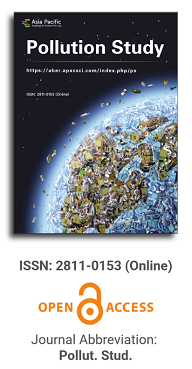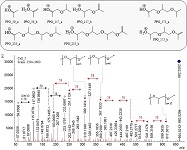
Asia Pacific Academy of Science Pte. Ltd. (APACSCI) specializes in international journal publishing. APACSCI adopts the open access publishing model and provides an important communication bridge for academic groups whose interest fields include engineering, technology, medicine, computer, mathematics, agriculture and forestry, and environment.

The (partial) replacement of synthetic polymers with bioplastics is due to increased production of conventional packaging plastics causing for severe environmental pollution with plastics waste. The bioplastics, however, represent complex mixtures of known and unknown (bio)polymers, fillers, plasticizers, stabilizers, flame retardant, pigments, antioxidants, hydrophobic polymers such as poly(lactic acid), polyethylene, polyesters, glycol, or poly(butylene succinate), and little is known of their chemical safety for both the environment and the human health. Polymerization reactions of bioplastics can produce no intentionally added chemicals to the bulk material, which could be toxic, as well. When polymers are used to food packing, then the latter chemicals could also migrate from the polymer to food. This fact compromises the safety for consumers, as well. The scarce data on chemical safety of bioplastics makes a gap in knowledge of their toxicity to humans and environment. Thus, development of exact analytical protocols for determining chemicals of bioplastics in environmental and food samples as well as packing polymers can only provide warrant for reliable conclusive evidence of their safety for both the human health and the environment. The task is compulsory according to legislation Directives valid to environmental protection, food control, and assessment of the risk to human health. The quantitative and structural determination of analytes is primary research task of analysis of polymers. The methods of mass spectrometry are fruitfully used for these purposes. Methodological development of exact analytical mass spectrometric tools for reliable structural analysis of bioplastics only guarantees their safety, efficacy, and quality to both humans and environment. This study, first, highlights innovative stochastic dynamics equations processing exactly mass spectrometric measurands and, thus, producing exact analyte quantification and 3D molecular and electronic structural analyses. There are determined synthetic polymers such as poly(ethylenglycol), poly(propylene glycol), and polyisoprene as well as biopolymers in bags for foodstuffs made from renewable cellulose and starch, and containing, in total within the 20,416–17,495 chemicals per sample of the composite biopolymers. Advantages of complementary employment in mass spectrometric methods and Fourier transform infrared spectroscopy is highlighted. The study utilizes ultra-high resolution electrospray ionization mass spectrometric and Fourier transform infrared spectroscopic data on biodegradable plastics bags for foodstuffs; high accuracy quantum chemical static methods, molecular dynamics; and chemometrics. There is achieved method performance |r| = 0.99981 determining poly(propylene glycol) in bag for foodstuff containing 20,416 species and using stochastic dynamics mass spectrometric formulas. The results highlight their great capability and applicability to the analytical science as well as relevance to both the fundamental research and to the industry.
Comparative evaluation of TPHs standards in the analysis of petroleum-contaminated, and remediated soil
Vol 6, Issue 1, 2025
Download PDF
Abstract
Commercially available Total Petroleum Hydrocarbons (TPHs) standards have been widely used for instrumental analysis of TPHs in soils and other environmental matrices. However, there are concerns about the universality of these standards developed in one region of the world to reliably estimate TPHs in environmental matrices in other regions, which prompted this investigation. TPHs standards were prepared from contaminating crude oils at polluted sites at Tibshelf, UK, and Ogoniland, Niger Delta, Nigeria. The prepared standards were used in comparison with some commercially available TPHs standards (TPHs-gasoline diesel range and TPHs C10-C40) for assessment of TPHs levels in the contaminated soil samples treated for phyto and myco-remediation. Results obtained revealed significant differences in the quantification of TPHs between these standards. The TPHs standards prepared from the contaminating crude oils estimated higher levels of TPHs in the soil samples compared to those of the commercially available standards. In assessing the % of TPHs reduction in the remediation experiment, all the standards provided similar estimations of TPHs reduction, with no significant differences. The result revealed that although all the TPHs standards provided consistent evaluation of TPHs remediation in all cases, the commercially available TPHs standards may underestimate the concentration of TPHs in certain environments during pollution incidents. Therefore, with respect to toxicological evaluations, there is a need for TPHs standards specifically developed for a region of interest to be used. This study offers a good insight on how such standards can be prepared.
Keywords
References
- Kuppusamy S, Maddela NR, Megharaj M, et al. Total Petroleum Hydrocarbons. Springer International Publishing; 2020. doi: 10.1007/978-3-030-24035-6
- Ashjar N, Keshavarzi B, Moore F, et al. TPH and PAHs in an oil-rich metropolis in SW Iran: Implication for source apportionment and human health. Human and Ecological Risk Assessment: An International Journal. 2021: 1-21. doi: 10.1080/10807039.2021.2015285
- Shishkova I, Stratiev D, Kolev IV, et al. Challenges in Petroleum Characterization—A Review. Energies. 2022; 15(20): 7765. doi: 10.3390/en15207765
- Michelsen TC, Boyce CP. Cleanup standards for petroleum hydrocarbons. Part 1. Review of methods and recent developments. Journal of Soil Contamination. 1993; 2(2): 109-124. doi: 10.1080/15320389309383432
- Okparanma RN, Mouazen AM. Determination of Total Petroleum Hydrocarbon (TPH) and Polycyclic Aromatic Hydrocarbon (PAH) in Soils: A Review of Spectroscopic and Nonspectroscopic Techniques. Applied Spectroscopy Reviews. 2013; 48(6): 458-486. doi: 10.1080/05704928.2012.736048
- Harmsen J, Hutter JW, Win T, et al. Risk assessment for mineral oil: development of standardized analitical methods in soil and soil-like materials. 2015; 1225.
- Dickson UJ, Coffey M, George Mortimer RJ, et al. Investigating the potential of sunflower species, fermented palm wine and Pleurotus ostreatus for treatment of petroleum-contaminated soil. Chemosphere. 2020; 240: 124881. doi: 10.1016/j.chemosphere.2019.124881
- USEPA METHOD 3546. Microwave Assisted Extraction of Total Petroleum Hydrocarbons from Soils and Sediments. Available online: https://www.epa.gov/hw-sw846/sw-846-test-method-3546-microwave-extraction (accessed on 26 December 2024).
- Punt MM, Raghavan GSV, Bélanger JMR, et al. Microwave-Assisted Process (MAPTM) for the Extraction of Contaminants from Soil. Journal of Soil Contamination. 1999; 8(5): 577-592. doi: 10.1080/10588339991339487
- ISO/TS 16558-2: International Organization for Standardization (2015) ISO/TS 16558-2: soil quality - risk-based petroleum hydrocarbons; part 2: determination of aliphatic and aromatic fractions of semi-volatile petroleum hydrocarbons using gas chromatography with flame ionization detection (GC/FID). (ISO: Geneva, Switzerland). Available online: https://www.iso.org/standard/59263.html (accessed on 26 December 2024).
- ISO 18287:2006. Soil quality—Determination of polycyclic aromatic hydrocarbons (PAH) — Gas chromatographic method with mass spectrometric detection (GC-MS). Available online: https://www.iso.org/standard/33387.html (accessed on 26 December 2024).
- BS EN ISO 16703: 2011. Soil Quality-Determination of Content of Hydrocarbon in the Range C10 to C40 by Gas Chromatography. Available online: https://standards.iteh.ai/catalog/standards/cen/fd8a54c3-ddb7-4a7c-8e57-dc915aedd62c/en-iso-16703-2011?srsltid=AfmBOopP7qVhR0tXrYslj_t39Uj6jKsUOwzBmZ987QpNanrdO6MQoXA7 (accessed on 26 December 2024).
- ISO 13859:2014Soil quality — Determination of polycyclic aromatic hydrocarbons (PAH) by gas chromatography (GC) and high performance liquid chromatography (HPLC). Available online: https:// https://www.iso.org/standard/54337.html (accessed on 26 December 2024).
- US EPA Method 8270 (PAH only): GC Analysis of PAHs on SLB®-5ms. Environmental Protection Agency, Office of Research and Development, Washington, DC. https://19january2017snapshot.epa.gov/sites/production/files/2015-07/documents/epa-8270d.pdf (accessed on 26 December 2024).
- Weber S, Schrag K, Mildau G, et al. Analytical Methods for the Determination of Mineral Oil Saturated Hydrocarbons (MOSH) and Mineral Oil Aromatic Hydrocarbons (MOAH)—A Short Review. Analytical Chemistry Insights. 2018; 13. doi: 10.1177/1177390118777757
- Dahl M, Survo S, Välitalo P, et al. Identification of Toxicants from a Highly C10–C40-Contaminated Sediment Influenced by the Wood Industry: Petroleum Hydrocarbons or Biogenic Organic Compounds? Environmental Toxicology and Chemistry. 2019; 38(5): 936-946. doi: 10.1002/etc.4380
- ASTDR-Agency for Toxic Substances and Disease Registry. Available online: https://www.atsdr.cdc.gov/toxprofiles/tp123.pdf (accessed on 26 December 2024).
- Filewood T, Kwok H, Brunswick P, et al. A rapid gas chromatography quadrupole time-of-flight mass spectrometry method for the determination of polycyclic aromatic hydrocarbons and sulfur heterocycles in spilled crude oils. Analytical Methods. 2022; 14(7): 717-725. doi: 10.1039/d1ay02216d
- Frantsina EV, Grinko AA, Krivtsova NI, et al. Identification of hydrocarbon compositions of diesel fractions and assessment of their effect on fuel operational characteristics. Petroleum Science and Technology. 2019; 38(4): 338-344. doi: 10.1080/10916466.2019.1705856
- Mota MFS, Waktola HD, Nolvachai Y, et al. Gas chromatography ‒ mass spectrometry for characterisation, assessment of quality and authentication of seed and vegetable oils. TrAC Trends in Analytical Chemistry. 2021; 138: 116238. doi: 10.1016/j.trac.2021.116238
- Alkhafaji MW. Biomarker assessment of oil biodegradation, water washing, and source rock characteristics of oil seeps from the Foothill Zone along the Tigris River, Northern Iraq. Journal of Petroleum Science and Engineering. 2021; 197: 107946. doi: 10.1016/j.petrol.2020.107946
- Chuah LF, Chew KW, Bokhari A, et al. Biodegradation of crude oil in seawater by using a consortium of symbiotic bacteria. Environmental Research. 2022; 213: 113721. doi: 10.1016/j.envres.2022.113721
- Ambaye TG, Chebbi A, Formicola F, et al. Remediation of soil polluted with petroleum hydrocarbons and its reuse for agriculture: Recent progress, challenges, and perspectives. Chemosphere. 2022; 293: 133572. doi: 10.1016/j.chemosphere.2022.133572
- Liu Q, Xia C, Wang L, et al. Fingerprint analysis reveals sources of petroleum hydrocarbons in soils of different geographical oilfields of China and its ecological assessment. Scientific Reports. 2022; 12(1). doi: 10.1038/s41598-022-08906-6
- Omokpariola DO, Nduka JK, Kelle HI, et al. Chemometrics, health risk assessment and probable sources of soluble total petroleum hydrocarbons in atmospheric rainwater, Rivers State, Nigeria. Scientific Reports. 2022; 12(1). doi: 10.1038/s41598-022-15677-7
- Arekhi M, Terry LG, John GF, et al. Environmental fate of petroleum biomarkers in Deepwater Horizon oil spill residues over the past 10 years. Science of The Total Environment. 2021; 791: 148056. doi: 10.1016/j.scitotenv.2021.148056
- Iturbe, Rosario, Carlos Flores, Rosa Ma Flores, et al. Subsoil TPH and other petroleum fractions-contamination levels in an oil storage and distribution station in north-central Mexico. Chemosphere 61. 2005; 11: 1618-1631.
- Yang ZH, Lien PJ, Huang WS, et al. Development of the risk assessment and management strategies for TPH-contaminated sites using TPH fraction methods. Journal of Hazardous, Toxic, and Radioactive Waste. 2017; 21(1): D4015003.
- Iturbe R, Flores-Serrano RM, Castro A, et al. Subsoil TPH contamination in two oil pipeline pumping stations and one pipeline right-of-way in north Mexico. Journal of Environmental Management. 2010; 91(11): 2396-2402. doi: 10.1016/j.jenvman.2010.07.003
- Sari G, Trihadiningrum Y, Ni’matuzahroh N. Petroleum Hydrocarbon Pollution in Soil and Surface Water by Public Oil Fields in Wonocolo Sub-district, Indonesia. Journal of Ecological Engineering. 2018; 19(2): 184-193. doi: 10.12911/22998993/82800
Supporting Agencies
Copyright (c) 2025 Author(s)
License URL: https://creativecommons.org/licenses/by/4.0/

This site is licensed under a Creative Commons Attribution 4.0 International License (CC BY 4.0).
.jpg)
Beijing University of Technology, China



